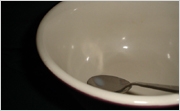 |
 |
 |
 |
|||||


‘Why One Must Not Hop on Pop’
by
In the last thirty years, the shelves of libraries and professors' classrooms have been flooded with an inestimable tide of authors devoted to supporting works laced with relativistic values that have punctuated postmodernism. However, many pieces of classic literature have been passed down in our classrooms for generations. Today, these authors' styles and forms are picked apart and examined in order to bolster our aspirations of achieving great literary form. Indeed, the experiences that shapes the lives and works of these authors is heavily scrutinized by today's intellectuals as if each individual artist could serve as a psychological case study. The lives of writers such as the Brontës, James Joyce and even Ernest Hemingway (who, himself, realized he was an asshole rather than a philosopher before he died--see A Moveable Feast) have been used to shed great insight on both the themes contained within their work as well as their respective literary styles.
These texts have remained active in our cultural identity for more than their educational value; however, it is the lack of relativism in their perspective, the union between these artists' lives, their work and their perceptions that still draw readers to them. As the new century dawns and the intellectuals gain greater perspective on the course of societies across the planet, many of these authors' insights into the course of human nature will be more heavily examined and validated albeit posthumously.
Of the collected texts written by 'great American writers' of the twentieth century, one has not only been preserved for its dynamic style, but also because its words foreshadowed the intellectual rationalization of human nature years before the postmodern era ever ambled to center stage of the artistic world.
Those in the know (English professors, freelance artists, literature enthusiasts, people who enjoy bright pictures, et al.) have likely already recognized the titular subject of this article. They have likely spent many an evening combing over its pages. While such a work needs practically no introduction (for could any introduction truly equal such a finely-crafted tome's finesse?) for the sake of those poorly informed as well as to emphasize the cautionary themes involved in the novel, I will name it here.
I am, of course, referencing one of the works of a late twentieth century author. It was dismissed in his waning years as an experimental attempt to reinvent his style and canonized by the intellectual elite after his death for its paradoxical dynamics and subtle prose: Dr. Seuss's Hop on Pop.
Some of you will chortle or snicker at this work of 'childrens' literature.' I beg you, hear me out. Seuss took a simple phrase--one which could be understood by a child--and crafted the Great American Novel. It has all the integral components. Exposition. Rising Action. Climax. Falling Action. Denouement.
At mere glance, one could easily draw parallels between Hop and many of what some researchers have referred to as Seuss's 'distinct object period.' Long-time readers will find grammatical and even thematic construction similar to works such as One Fish, Two Fish, Red Fish, Blue Fish as well as Fox in Sox. Clearly, there is no similarity between Hop and Fox. The latter is mere showboating on Seuss's part. Tongue-twisters to entertain the masses and educate children on proper diction. However, the underlying themes in Hop are quite serious and, when looked at individually, far from entertaining. More elaborate and subtle designs are at work in Hop than the intellectual landscape that Seuss was fond of painting.
Controversy surrounding One Fish's subversive themes--the inability to distinguish the many variables that construct an individual's identity (red or blue?) and, unspoken, the emphasis of the same isolation which struck authors predating Seuss including Joyce, Conrad and Virginia Woolf--rocked universities, kindergartens and backyards around the country while Hop was passed over completely. It was considered innocuous and many readers felt it was 'more of the same.'
Such an assessment couldn't be further from the truth. The impact of Hop was not lessened by the passage of time, nor by Seuss’s relentlessly rehashing his previously published material. Seuss's tone, for the first time in years, took a distinctly different turn with Hop. It was perhaps so drastically different that many would dig for subversive themes and imply language that was never intended to be seen in his work. Seuss did not construct Hop to baffle, confuse or even experiment with his style. His tone, for once, is direct. In fact, the rising and falling action of the characters in his story and the resolution of Hop's conflict reflect Seuss's personal views on society's natural evolution. What he saw as society's path is not for anyone else to surmise. Despite this, it must be said that Seuss's tone here is self-referential: inevitability hangs heavy in Hop's prose from its title to its stunning finale. Seuss no longer spoke from a reference point or even through another character. He spoke, for the first time, in his own voice and constructed his piece without duplicity in its grammar or themes. As we will come to see, it is this very duplicity and blending of the truth that Seuss greatly feared would bring about society's downfall.
Seuss's direct tone can also be seen in his repetitiveness. While many assumed such an artistic choice was merely to emphasize the urgency in Hop's climax (two younger beings are revealed their mandate: learning they must not hop on Pop), that the good Doctor's repetition is meant to emphasize the directness with which the protagonists--in truth, society--must be guided and must embrace to guide others in turn.
A far more elegant phenomenon scattered throughout the text closely parallels the literal enmeshment that contemporaries such as Woolf were known for. It represents the conflict embedded in the core of not just Seuss's novel, but his very philosophy. It is not merely an arbitrary choice that Seuss's protagnoists are nameless, nearly identical fuzzy (read: happy) creatures of unknown origin. In fact, such a calculated choice speaks to Seuss's desire to address the facelessness which he saw growing in our society. This was more than the growth of mere numbers--more than a fear of overcrowding or of class warfare. Seuss's fear was that soceity would blend together into a single being. Seuss's protagonists are not truly 'faceless,' rather they are the same face.
Seuss feared the rationalization of identity through the growing field of psychology and the replacement of spirituality by science. Hop served as his plea for the long life of individuality. But even he recognized that the 'birth' of such postmodern relativism, the manner in which it would take root in future generations (producing same-faced, small, fuzzy creatures of unknown origin) could not truly be prevented. In this way, Seuss sets the stage for the growth of his protagonists and their eventual transformation. He waxes about the possibilities of future transitions even while recognizing the current transition being set in motion.
These themes of lack of identity and coagulation are further echoed in the elaborate alliterations that pervade Hop. The first page states: "Up Pup. PUP is UP." Pup is labeled as Up. Because of what and how he is, he's given that label. His real identity no longer known, he is now referred to as Up.
Seuss builds on this simple idea and brings it all to a head with the eventual hopping on Pop. While variations of the message are conveyed, no piece of alernate knowledge is offered in an alliterative form resembling the climax. Seuss's mandate is direct. Its content is immaculately distinct. He speaks to "YOU."
You MUST not hop on Pop!...STOP!
It is with this simple command that Seuss cuts to the chase. We must stop. We must stop or else face conformity and a homogenized version of our society. A society, mind you, that since Seuss's death has fallen into artistic disrepair. Our storytellers are bought and sold through Disney. Everyone wears a happy face. The same unrecognizable, fuzzy face (see: Lilo and Stitch). We are all one and we are all Pop. It is this abuse of self that Seuss warned us against. He foresaw what postmodernism would bring. Trust in his simple instructions. Stop hopping else it will be the end of us all.

